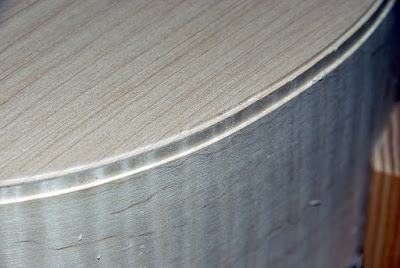At the end of the summer Matt and I built a little jig to help laminate plastic binding strips together. It was a simple little contraption based on a Stewart-MacDonald design that I had seen in their catalog.
 |
| Binding Laminator |
 |
| Laminator |
 |
| Laminator in vise |
 |
| Running black and white binding through spring loaded jig. |
 |
| Pulling binding sandwich through. |
 |
| applying acetone as glue. |
 |
| All the materials. |
 |
| The edge guide attached to the Dremel tool. |
 |
| The Dremel tool routing the purfling channel on the back. |
 |
| The Dremel routing the binding channel on the back. |
 |
| Binding and purfling channels on the back. |
 |
| Detail of both channels. |
 |
| Detail of both channels on the back. |
 |
| Channels being routed on top. |
 |
| Top with channels cut. |
After the channels were routed in both the top and back they needed to be cleaned up with an assortment of small jewelers files, fingernail files and emery boards. The channels needed to be burr free and a consistent depth to fit the bindings. At this point I realized I had some problems with consistency in my channel width. After close examination I saw that I had a couple of places on the top of the back that the channels were not as wide as they should be. I think the reason for this inconsistency was due to some imperfections in the sides caused in the bending process. I now think that if I had spent some time sanding out the sides this might not have been as big a problem. The edge guide uses the sides as a bumper/guide to control the cut. If there is a bump or valley it will be transferred to the channel cut. Also, if the sides are not perfectly square (which I am sure mine were not) the channels will not be consistent. I spent a lot of time trying to work out the inconsistency in the channels and still had some problems when I glued the bindings in place.
 |
| An emery board makes a great tool because it is flexible. |
 |
| Tools used to clean up channels. |
 |
| Applying the tape to hold the glued binding in position |
 |
| Purfling glued in position. |
 |
| Detail of purfling. |
 |
| Detail of purfling. |
 |
| Detail of purfling showing the end seam. |
 |
| Binding on back fully taped. |
 |
| Purfling on top fully taped. |
 |
| Binding and purfling installed. |
 |
| Detail of binding and purfling at waist of top. |
 |
| Binding and purfling on back. |
 |
| Completed binding. |
 |
| The materials. |












No comments:
Post a Comment